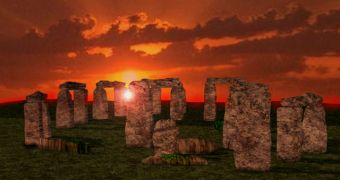A recent study on Stonehenge comes to thwart the conclusions of the preceding ones, by claiming that the monument was, in fact, not a healing center, as it was demonstrated a few weeks ago, but a cremating cemetery.
This discovery provides further fuel for the century-old ongoing debate over the purposes of England's most famous monument. As it was showed in the report, the “56 Welsh bluestones” were placed “in a ring 285 feet 6 inches across” sometime “very early in Stonehenge's history” in order to replace older wood pillars. This switching to stone was dated by the research in about 3000 BC, seven centuries earlier than the previous estimation. A group of archaeologists from various British universities conducting excavations on the site for the last five years investigated some remains from the “Aubrey Hole,” one of the small pits believed to have contained a wood post, before it was replaced by a stone one.
The crushed bits of chalk uncovered there provided the team with clues on the date when the structure was erected, while shedding some light on the usage of the monument for cremating purposes. This backed the evidence provided by dating some human remains from the site with radiocarbon, which also yielded a result that pinpointed the event to sometime between 2300 and 3000 BC. These pieces of evidence led the scientists to conclude that the cremation practice took place even long after the standing stones were brought into place, contrary to what a BBC documentary had previously claimed.
The team's report explains, “Contrary to claims made in the recent BBC Timewatch film, which promoted a theory of Stonehenge as a healing center built after the practice of cremation burial had ceased, standing stones and burial may have been prominent aspects of Stonehenge's meaning and purpose for a millennium”. Mike Pitts, editor at British Archeology and one of the study authors, reveals the implications, “This means there were earlier connections with Wales, where the standing stones came from, than previously thought and that Stonehenge was always about death and ancestors and burial and not healing”. But, according to Geoffrey Wainwright, one of the archaeologists who worked on the BBC documentary, this doesn't exclude the hypothesis of Stonehenge as a healing center, “We do not claim Stonehenge was a single use monument," he said. "We think it was a multifunctional monument and part of its purpose was for healing.”

 14 DAY TRIAL //
14 DAY TRIAL //